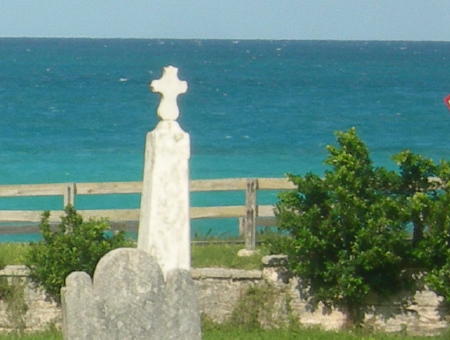





|
|
|
|
August 23, 2006
Poseidon's passion under the bridge
On the way to Bermuda, I passed under the Delaware Memorial Bridge -- the "the world's longest twin suspension bridge." As photo opportunities go, the bridge was hard to resist.

Work began on the church in 1874, but ended when the church was beset by financial difficulties and a schism in the Anglican congregation.Anglican schisms? I thought that was a new idea... From the looks of the photo, I'm behaving like a Rasputin ne'er-do-well -- while the church splits into pieces:

I took the next couple of pictures in a very old, very spooky cemetery which overlooks the Atlantic ocean.



"Passion" does not refer to love, but to the Passion of Christ on the cross. In the 15th and 16th centuries, Spanish Christian missionaries discovered this flower and adopted its unique physical structures as symbols of Crucifixion. For example: the 72 radial filaments (or corona) represent the Crown of Thorns. The ten petals and sepals represent the ten faithful apostles. The top 3 stigma represent the 3 nails and the lower 5 anthers represent the 5 wounds. The flower has been given names related to this symbolism throughout Europe since that time. In Spain, it is known as Espina de Cristo (Christ's Thorn). In Germany it was once known as Muttergottes-Schuzchen (Mother-of-God's Star).The Apostles? The Crown of Thorns? Sheesh! I didn't see any of those things in the flower, and it didn't occur to me to count the radial filaments, the petals, the sepals, the stigma, or the anthers. Anthers? I have only questhions!

Anyway, I made it back in one piece. Considering that the trip was accomplished entirely by ship, I'm glad that while in Bermuda I paid homage to Poseidon, known Homerically as the savior of ships.  Obviously, I can't claim that this accounts for the calm seas which accompanied the ship, but can anyone say that it hurt? Poseidon, one of the most powerful gods, did not behave in what would today be considered a godly manner: He had many love affairs and fathered numerous children. Poseidon once married a Nereid, Amphitrite, and produced Triton who was half-human and half-fish. He also impregnated the Gorgon Medusa to conceive Chrysaor and Pegasus, the flying horse. The rape of Aethra by Poseidon resulted in the birth of Theseus; and he turned Caeneus into a man, at her request, after raping her. Another rape involved Amymone when she tried to escape from a satyr and Poseidon saved her. Other offspring of Poseidon include: Eumolpus, the Giant Sinis, Polyphemus, Orion, King Amycus, Proteus, Agenor and Belus from Europa, Pelias, and the King of Egypt, Busiris.Impregnating Medusa? Reading stuff like that makes me wonder whether there's a connection between the ancients and the fact that even today, ships are referred to in the feminine gender: ....when we refer to a ship as a she, we are assigning to it a gender, and, incidentally, the same gender the Romans assigned, feminine.But not the Russians, the Germans, or the French. Nor the very influential Lloyds of London, which has neutered ship gender in an obvious bow to political correctness. Does every last goddamned thing in this world have to become political? While none of this is new, it's probably worth pointing out that various offended people have decried "sexist" ship gender at Wikipedia, but there's a more interesting debate here. However, here's a feminist classical scholar who disagrees with the stultifying grammatical view of conventional feminism: A feminist note on the gender of ships: Because of the living qualities of ships, I like to refer to a ship as "she" rather than "it." While some may compare a vessel to a woman because of the supposedly capricious nature of both (although there seems nothing wrong with an occasional playful moment), I think that this view overlooks other qualities. Ships, like women, are beautiful, swift, intelligent, and powerful. I am glad to acclaim them as my sisters!I don't think Poseidon would mind. posted by Eric on 08.23.06 at 08:32 AM
Comments
Thanks Dennis. The use of the feminine pronoun for ships would seem to be relatively modern. (In ancient terms, of course.) Eric Scheie · August 23, 2006 11:40 AM When Admiral Nimitz was asked by reporters why ships were referred by in the feminine gender, he was said to have replied: Natrium · August 23, 2006 12:31 PM I think the practice of referring to ships as feminine in English probably arose thanks to speakers who learned Latin as the foundation of good speech, and navis (fem.) was the good, classical word that they learned for ship. In fact, ships were masculine for centuries in English before the 19th century, but in the mediaeval period up to the 16th or 17th century ships were feminine, probably owing to the influence of French nef, derived from Latin navis. The influence of French in the early period, like that of Latin later, was part and parcel to the snobbish appeal of a literary language. A lot of phantom grammatical 'rules' in English, like split infinitives and ending a clause with a preposition, are the result of appeals to Latin grammar in comparatively recent times. I think it likely that the romantic idea of the ship as a lady came later. People continue to argue that it has to do with the ship as a mother, or a lover, etc., but then how does that compete with the traditional superstition about women on ships? Fear of a cat fight? I suspect that similar usages, like the soul or one's country as feminine, are likewise influenced by gender. The soul is anima (fem.), and fatherland is patria, which is feminine (concealing terra, land) even though it uses the root for father. A great coincidence in one language led to a charming usage in another, but I don't see any sexism here. Dennis · August 23, 2006 12:33 PM The matter of characterizing what Neptune did with some of the ladies he rescued as rape, is pretty much a matter of some Victorian Era types expressing disapproval of what was likely a common practice when back when. Namely, you rescued a lady she thanked you by jumping your bones. It's a practice people are still engaging in. Alan Kellogg · August 23, 2006 09:00 PM Awesome post! :) Harkonnendog · August 23, 2006 09:28 PM Thanks Hark! Eric Scheie · August 24, 2006 09:46 AM |
|
March 2007
WORLD-WIDE CALENDAR
Search the Site
E-mail
Classics To Go
Archives
March 2007
February 2007 January 2007 December 2006 November 2006 October 2006 September 2006 August 2006 July 2006 June 2006 May 2006 April 2006 March 2006 February 2006 January 2006 December 2005 November 2005 October 2005 September 2005 August 2005 July 2005 June 2005 May 2005 April 2005 March 2005 February 2005 January 2005 December 2004 November 2004 October 2004 September 2004 August 2004 July 2004 June 2004 May 2004 April 2004 March 2004 February 2004 January 2004 December 2003 November 2003 October 2003 September 2003 August 2003 July 2003 June 2003 May 2003 May 2002 See more archives here Old (Blogspot) archives
Recent Entries
• War For Profit
• How trying to prevent genocide becomes genocide • I Have Not Yet Begun To Fight • Wind Boom • Isaiah Washington, victim • Hippie Shirts • A cunning exercise in liberation linguistics? • Sometimes unprincipled demagogues are better than principled activists • PETA agrees -- with me! • The high pitched squeal of small carbon footprints
Links
Site Credits
|
|
On the gender of ships:
The gender of nouns in Indo-European languages (like Greek and Latin) is a non-issue in most cases because things generally weren't conceived of as male or female, but rather as masculine or feminine by analogy. This was a purely grammatical consideration, usually determined not by the 'sex' of the thing but by the stem, except when sex trumped grammatical gender, as in the few Latin masculine words of the 1st declension which refer to male occupations (all other 1st declension nouns are feminine in Latin).
The common word for ship in Greek (naus) and Latin (navis) is common also to Sanskrit (nau), and it is a very ancient Indo-European word (root *neH2u-) whose historical development is unclear. It seems, though, that the stem of the word classified it as feminine, not ideas about the 'femaleness' of ships.
Before ancient Indians, Greeks, or Romans ever thought about the role of women in society, the word for ship was gramamtically feminine, and it stayed that way. Grammatical gender, as I've said, usually had nothing to do with sex. It was an unavoidable part of language without any ulterior motives, and it's unrealistic to suppose that native speakers would have reacted to it the same way that we do.
Also it should be noted that each of these languages had several other words for ship of all genders.